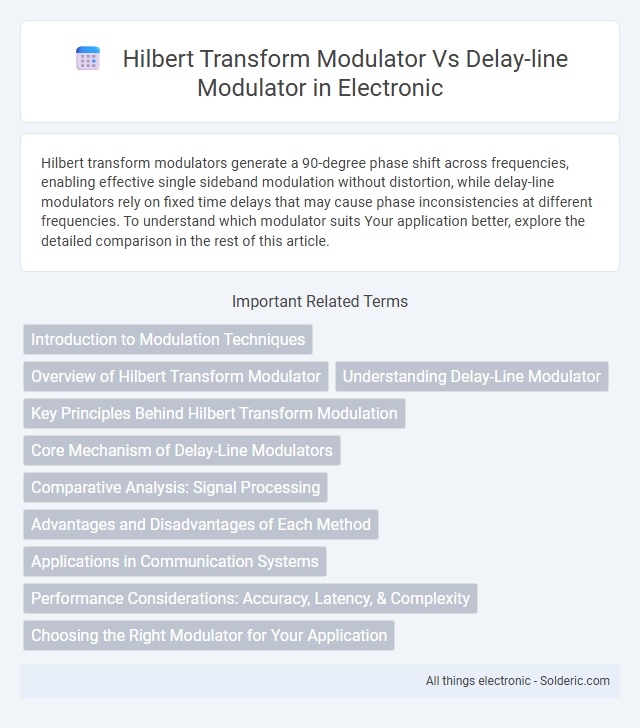Hilbert transform modulators generate a 90-degree phase shift across frequencies, enabling effective single sideband modulation without distortion, while delay-line modulators rely on fixed time delays that may cause phase inconsistencies at different frequencies. To understand which modulator suits Your application better, explore the detailed comparison in the rest of this article.
Comparison Table
| Feature | Hilbert Transform Modulator | Delay-Line Modulator |
|---|---|---|
| Principle | Uses Hilbert transform to generate a 90deg phase-shifted signal | Uses physical delay lines for phase shifting |
| Phase Shift Accuracy | High accuracy over narrow bandwidth | Dependent on precise delay matching; accurate over limited bandwidth |
| Bandwidth | Typically narrow to moderate bandwidth | Limited by delay line and frequency range |
| Implementation Complexity | Requires digital or analog filter design | Simple, physical hardware (coaxial cables, etc.) |
| Size and Cost | Compact; can be integrated on chip | Bulky due to physical delay components; higher cost |
| Temperature Stability | Dependent on electronic components; better in integrated circuits | Susceptible to temperature changes affecting delay |
| Applications | Signal processing, communications, analytic signal generation | Radar, communications, simple modulator implementations |
Introduction to Modulation Techniques
Hilbert transform modulators create a 90-degree phase shift essential for generating single-sideband signals, enabling efficient bandwidth usage in communication systems. Delay-line modulators rely on time delays to achieve phase shifts, suitable for narrowband applications but less effective for wideband signals compared to Hilbert modulators. Your choice of modulation technique impacts signal clarity, bandwidth efficiency, and system complexity, making the Hilbert transform modulator preferable for advanced, broadband communication tasks.
Overview of Hilbert Transform Modulator
The Hilbert transform modulator generates a 90-degree phase-shifted version of the input signal, enabling the creation of single sideband (SSB) signals by suppressing one sideband effectively. It uses the analytic signal concept, where the Hilbert transform provides the quadrature component, improving spectral efficiency and reducing interference. This modulator is essential in communication systems requiring bandwidth conservation and precise phase control compared to delay-line modulators.
Understanding Delay-Line Modulator
Delay-line modulators employ a time-shifted version of the input signal to create phase-shift keying or amplitude modulation effects by introducing controlled delays, enabling precise manipulation of the signal envelope and phase. This approach contrasts with Hilbert transform modulators, which generate orthogonal components by using a 90-degree phase-shifted version of the signal, typically achieved through an analytic signal framework. Delay-line modulators excel in applications demanding adjustable delay and fine control over transient response, making them suitable for dynamic signal processing in communications and radar systems.
Key Principles Behind Hilbert Transform Modulation
Hilbert transform modulation relies on generating a 90-degree phase-shifted version of the input signal to create a complex analytic signal, enabling amplitude and phase manipulation without distortion. This method enhances modulation accuracy by preserving the signal's envelope and instantaneous frequency, making it ideal for single-sideband and quadrature modulation schemes. Your communication system benefits from improved spectral efficiency and reduced interference compared to delay-line modulators, which introduce fixed time delays and may cause phase mismatches.
Core Mechanism of Delay-Line Modulators
Delay-line modulators operate by introducing precise time shifts to the input signal, creating phase shifts essential for modulation. Utilizing a feedback loop, the delay line controls the signal's timing, enabling frequency or phase modulation with minimal distortion. This mechanism contrasts with Hilbert transform modulators, which generate quadrature signals through a 90-degree phase shift filter rather than time delays.
Comparative Analysis: Signal Processing
Hilbert transform modulators generate a 90-degree phase shift by applying a precise analytic signal transformation, enhancing the accuracy of quadrature signal generation in complex modulation schemes. Delay-line modulators rely on physical time delays, resulting in potential signal distortion and reduced performance at higher frequencies due to bandwidth limitations. Your choice between the two depends on the required signal fidelity and processing speed, with Hilbert transform modulators offering superior phase accuracy for advanced communication systems.
Advantages and Disadvantages of Each Method
Hilbert transform modulators offer precise phase shifting crucial for single-sideband modulation, enabling better spectral efficiency but often require complex filter designs and are sensitive to implementation errors. Delay-line modulators provide simpler and more straightforward phase shifting through time delays, which makes them easier to implement and robust at lower frequencies but can introduce distortion and phase inaccuracies at higher frequencies. Your choice between these modulators depends on the application's frequency range, desired signal quality, and hardware complexity constraints.
Applications in Communication Systems
Hilbert transform modulators are extensively utilized in communication systems for generating single-sideband (SSB) signals and quadrature modulation schemes, which improve bandwidth efficiency and reduce interference. Delay-line modulators are commonly applied in systems requiring precise phase shifts for signal synchronization and echo cancellation, crucial in radar and digital communication. Both modulators play pivotal roles in enhancing signal integrity and spectral efficiency in modern wireless and optical communication frameworks.
Performance Considerations: Accuracy, Latency, & Complexity
Hilbert transform modulators offer high accuracy in generating quadrature signals with minimal amplitude and phase distortion, but they often introduce longer latency and increased computational complexity due to their filter-based implementation. Delay-line modulators provide lower latency by using time shifts to achieve quadrature components, making them simpler to implement digitally, though this can come at the cost of reduced accuracy and phase linearity. Choosing between these modulators depends on your application's performance priorities, balancing the trade-offs among accuracy, latency, and system complexity.
Choosing the Right Modulator for Your Application
When choosing the right modulator for your application, consider that Hilbert transform modulators excel in providing accurate phase shifting and improved signal orthogonality, ideal for complex signal processing tasks like quadrature amplitude modulation. Delay-line modulators offer simpler implementation and lower latency, making them suitable for real-time applications requiring minimal computational overhead. Your selection depends on balancing the need for precise phase control against system complexity and processing speed.
Hilbert transform modulator vs delay-line modulator Infographic

 solderic.com
solderic.com